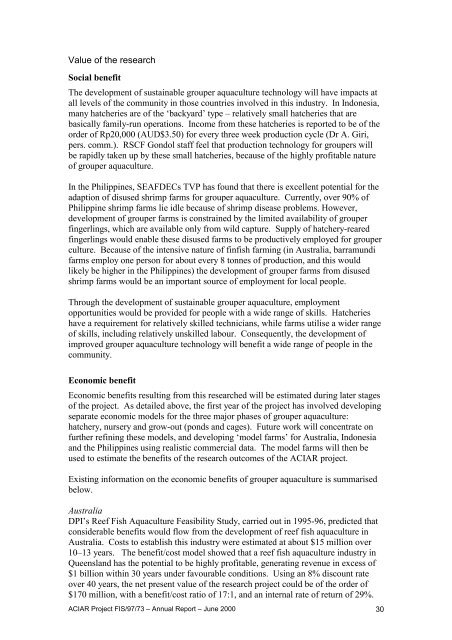ACIAR Project FIS/97/73 - Library - Network of Aquaculture Centres ...
ACIAR Project FIS/97/73 - Library - Network of Aquaculture Centres ...
ACIAR Project FIS/97/73 - Library - Network of Aquaculture Centres ...
You also want an ePaper? Increase the reach of your titles
YUMPU automatically turns print PDFs into web optimized ePapers that Google loves.
Value <strong>of</strong> the researchSocial benefitThe development <strong>of</strong> sustainable grouper aquaculture technology will have impacts atall levels <strong>of</strong> the community in those countries involved in this industry. In Indonesia,many hatcheries are <strong>of</strong> the ‘backyard’ type – relatively small hatcheries that arebasically family-run operations. Income from these hatcheries is reported to be <strong>of</strong> theorder <strong>of</strong> Rp20,000 (AUD$3.50) for every three week production cycle (Dr A. Giri,pers. comm.). RSCF Gondol staff feel that production technology for groupers willbe rapidly taken up by these small hatcheries, because <strong>of</strong> the highly pr<strong>of</strong>itable nature<strong>of</strong> grouper aquaculture.In the Philippines, SEAFDECs TVP has found that there is excellent potential for theadaption <strong>of</strong> disused shrimp farms for grouper aquaculture. Currently, over 90% <strong>of</strong>Philippine shrimp farms lie idle because <strong>of</strong> shrimp disease problems. However,development <strong>of</strong> grouper farms is constrained by the limited availability <strong>of</strong> grouperfingerlings, which are available only from wild capture. Supply <strong>of</strong> hatchery-rearedfingerlings would enable these disused farms to be productively employed for grouperculture. Because <strong>of</strong> the intensive nature <strong>of</strong> finfish farming (in Australia, barramundifarms employ one person for about every 8 tonnes <strong>of</strong> production, and this wouldlikely be higher in the Philippines) the development <strong>of</strong> grouper farms from disusedshrimp farms would be an important source <strong>of</strong> employment for local people.Through the development <strong>of</strong> sustainable grouper aquaculture, employmentopportunities would be provided for people with a wide range <strong>of</strong> skills. Hatcherieshave a requirement for relatively skilled technicians, while farms utilise a wider range<strong>of</strong> skills, including relatively unskilled labour. Consequently, the development <strong>of</strong>improved grouper aquaculture technology will benefit a wide range <strong>of</strong> people in thecommunity.Economic benefitEconomic benefits resulting from this researched will be estimated during later stages<strong>of</strong> the project. As detailed above, the first year <strong>of</strong> the project has involved developingseparate economic models for the three major phases <strong>of</strong> grouper aquaculture:hatchery, nursery and grow-out (ponds and cages). Future work will concentrate onfurther refining these models, and developing ‘model farms’ for Australia, Indonesiaand the Philippines using realistic commercial data. The model farms will then beused to estimate the benefits <strong>of</strong> the research outcomes <strong>of</strong> the <strong>ACIAR</strong> project.Existing information on the economic benefits <strong>of</strong> grouper aquaculture is summarisedbelow.AustraliaDPI’s Reef Fish <strong>Aquaculture</strong> Feasibility Study, carried out in 1995-96, predicted thatconsiderable benefits would flow from the development <strong>of</strong> reef fish aquaculture inAustralia. Costs to establish this industry were estimated at about $15 million over10–13 years. The benefit/cost model showed that a reef fish aquaculture industry inQueensland has the potential to be highly pr<strong>of</strong>itable, generating revenue in excess <strong>of</strong>$1 billion within 30 years under favourable conditions. Using an 8% discount rateover 40 years, the net present value <strong>of</strong> the research project could be <strong>of</strong> the order <strong>of</strong>$170 million, with a benefit/cost ratio <strong>of</strong> 17:1, and an internal rate <strong>of</strong> return <strong>of</strong> 29%.<strong>ACIAR</strong> <strong>Project</strong> <strong>FIS</strong>/<strong>97</strong>/<strong>73</strong> – Annual Report – June 2000 30
















